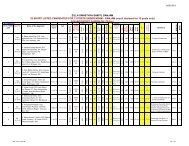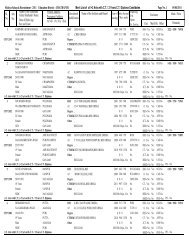Similar
Similar
Similar
Create successful ePaper yourself
Turn your PDF publications into a flip-book with our unique Google optimized e-Paper software.
Under utilized Dairy Potential<br />
The district has the distinction of having one of the largest bovine populations in the<br />
state. However the rearing is done in traditional way by way of which the domestic animals are<br />
used only as a drought proofing support by poor people. The non-availability of quality milch<br />
animals and scientific rearing are the main focus areas in this regards. At present six milk routs<br />
are operating in the district. Chilling plants at Berhampur, Aska & seven bulk cooling units<br />
established by OMFED (Orissa Milk Federation) & 188 Artificial Insemination centers augurs<br />
well for the development of Animal Husbandry as main activity of the rural masses of the<br />
district.<br />
Under developed Human Resource<br />
As regards to literacy rate, it is as low as 60.77% and the female literacy is just 46.44%.<br />
This is in contrast to the excellent educational infrastructure available in the district. Except the<br />
sex ratio district figures pertaining to important vital statistics such as TFR, life expectancy,<br />
MMR are not encouraging. In the age of knowledge and information until the people have<br />
some economic asset or some specialized or technical knowledge they can not participate in<br />
the economy and get benefited. So education is prerequisite for any intervention in the<br />
direction of livelihood security and economic wellbeing of the people the district.<br />
Inadequate health and sanitation awareness<br />
Ganjam district has a District Hospital with specialized services, two area hospitals,<br />
two sub- divisional hospitals, five CHC-I, five CHCs and 103 Primary Health Centers. Apart<br />
from these MKCG College Hospital provides referral facility for the patients. In spite of this<br />
the overall health situation of the district is not very different from the state scenario. AIDS<br />
and malaria are the main health related problems of the districts. The seasonal occurrences of<br />
cholera, dysentery and diarrhea are regular feature of the district. The situation is aggravated<br />
by prevalent traditions and superstitions mainly in the rural areas where the people rely on<br />
quacks. The poor sanitation leads to many health hazards.<br />
30
















